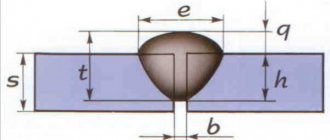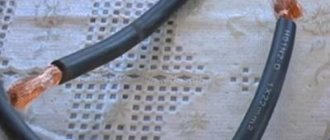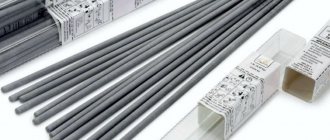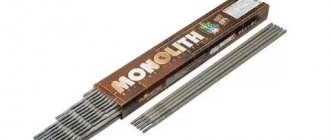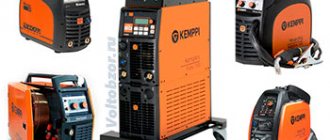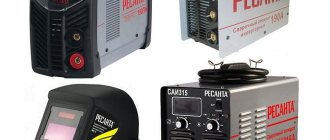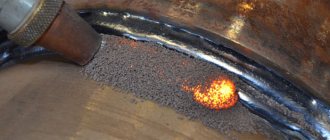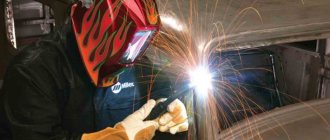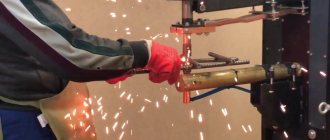To perform work related to manual arc welding of metal parts, you need not only a welding machine, but also additional accessories for it. They ensure correct assembly of the electrical circuit, are responsible for the reliability of contacts and create comfortable and safe conditions for the welder. These primarily include conductive cables, clamps and electrode holders. Such accessories are sold as part of the welder kit or purchased additionally. In any case, a novice master needs to know their purpose, main types and features of application.
Electric holder
The welding machine holder is designed to hold the electrode, supply voltage to it and control its position in the welding zone. It has simple but important requirements:
- reliable fixation of welding rods of various diameters in positions convenient for the welder;
- tight electrical contact;
- simple design ensuring long-term use of the electrode holder;
- ergonomics and safety.
All of the above qualities can be realized in different ways.
Peculiarities
The holder of the welding unit is a device that controls the electrode during welding work.
It must conscientiously hold an electrode of any cross-section and supply electric current to it, providing controlled control of the process without additional effort. The variety of designs also determines the variation in the technical and operational characteristics of the holders, however, there are also final values approved by GOST. For example, the length of the protected part of the handle must be at least 110 millimeters, and the average cross-section is in the range of 36-40 millimeters. The size of the clamp also affects the ability to work with electrodes designed for different levels of electrical current.
The initial level is 200-300 A; holders with a diameter of 36 millimeters function with similar parameters, and samples for 400-500 A, therefore, must have a cross-section of approximately 40 millimeters.
The materials used to make the device must also be taken into account. They also determine the ability to work with different limits of electric current strength, and resistance to adverse environmental conditions.
The combination of scale-resistant steel and high-strength plastic with corrugations on the surface will make it possible to protect the working base of the electrode holder from both high temperatures and cold if work takes place outdoors in winter.
Types of welding holders
Welding electric holders are classified according to their design and principle of electrode gripping. Almost all of them have a comfortable handle and a mechanical rod lock.
Clothespin holder
This type of holder uses a spring or lever mechanism to clamp the electrode. Their contact surfaces are made in the form of gear parts, allowing the rod to be quickly and firmly fixed in any position convenient for the welder. Most models have a dielectric outer coating, which increases safety for personnel and eliminates unintentional sparking. The main disadvantage of this design is the insufficient grip reliability when the spring weakens and the contacts wear out.
Fork trident
Such an electric holder can no longer be found in specialized stores, but old-school welders continue to use it. The electrode is held here due to the springing action of three steel rods welded together into a single structure vaguely reminiscent of a fork. This device is easily made by hand, but has a number of serious disadvantages:
- the presence of unprotected surfaces under voltage;
- difficulty in extracting the cinder;
- low ease of use.
Collet holder
Holders with a collet principle of electrode clamping have a slightly more complex design, which requires high precision in the manufacture of parts. They have found application in torches used for argon arc welding. They have a narrow scope of use and are quite expensive.
Non-burning holder
This type of holder consists of a handle and a contact pin. Before use, the electrode is welded to its end, which makes it possible to almost completely use the metal of the rod during the welding process. Devices of this design are in demand when working with expensive consumables.
Screw holder
The screw electric holder for welding inverter is highly popular among professionals. It most reliably fixes electrodes of any cross-section due to the threaded method of pressing. Products of this design have virtually no exposed areas, and this has a positive effect on safety. The need to periodically turn the screw slightly increases the time of fixing the rods, which is compensated by the strength of contact and ease of operation.
What is important when choosing a holder
An electric welder holds this device in his hands for a significant part of his working time, so his choice should be approached with maximum responsibility. An experienced master will definitely pay attention to the following points:
- weight, dimensions, ergonomic qualities of the handle;
- compliance of the product labeling with the range of current used in the upcoming work;
- possibility of reliable fixation of electrodes of the required diameter;
- ease of fastening the rod at different angles;
- quality of manufacture of live parts and clamping devices;
- the degree of outer coating of the holder with insulating materials;
- model cost.
Advice! For off-site work, it is advisable to always have a backup power holder.
Brief overview of popular holder models
Welding holders do not belong to the category of high-tech equipment. For a reasonable price, you can easily find a comfortable and durable model. To make the right choice, it is enough to know several brands from trusted manufacturers.
ESAB Handy 200
This model from the respected Swedish company ESAB is highly popular among professionals and amateurs. It is best suited for using electrodes with a diameter of 2 to 4 mm and is designed for a welding current of 200 amperes. Its weight of only 550 grams will not cause fatigue during the work shift. The screw clamp ensures quick replacement and reliable retention of rods fixed at an angle of 90° and 45°. Complete insulation of live parts guarantees the absence of accidental leaks. You can purchase the product for 500-600 rubles.
Sibrtech 91455
A domestic pincer-type model with a powerful spring costs only 200-250 rubles. It provides quick replacement of electrodes and their fixation in any direction. There are no restrictions on diameter. Current-carrying parts operate reliably at currents of up to 500 A. The product weighs less than 300 g. It has an ergonomic textured handle and a convenient clamp opening lever. The covering is made of durable insulating material.
Cedar Germany type 300A
Another Russian-made model with a pliers clamp, made of brass with a plastic coating. It weighs about 400 grams and is designed for welding current up to 300 amperes. The electrode can be easily installed in one of four possible positions. The handle does not slip in the hand and is not afraid of high temperature exposure. The price of a product of this brand starts from 300 rubles.
How to make magnetic mass for a welding machine at home?
Magnetic mass for welding is a special device that provides reliable fixation on metal surfaces. This allows you to comfortably perform welding work on complex surfaces where the use of classic alligator clips is impossible.
There are many design options that depend on the work conditions. The structure of this device is not particularly complicated. For this reason, some craftsmen prefer to use homemade magnets for welding.
What's happened?
This device is mounted on the working plane of the workpiece. Thanks to the active magnetic field, a strong fastening is achieved, creating a closed electrical circuit - the main condition for the formation of an electric welding arc.
The tool is especially popular among novice welders - it will take a few minutes to familiarize yourself with the principles of the work. Experienced specialists use magnetic mass for welding machines for critical work - welding large-diameter pipes or connecting load-bearing units made of profile materials.
Design of magnetic contact and its characteristics
Consists of two nodes:
- Cable holder. The ground cable of the welding equipment is attached to it using a bolted connection.
- Magnetic node. The size of the magnet depends on the design features. Some models are equipped with a mechanism that regulates the pressure of the magnet on the working plane. Professional devices have switches.
The parts are connected to each other by a rigid fastening. The main characteristics of the devices are:
- Dimensions and weight. Depends on the manufacturer and specific model. The average weight is 1-1.2 kg.
- The force of attraction to the surface. Varies in the range from 2 to 50 kg.
- Welding current strength. The maximum value of the parameter is measured in amperes. For entry-level models, it does not exceed 200 A. An advanced tool is capable of operating at 400-500 A.
- Execution type. They produce special clamps for corners with gap adjustment.
Is it worth buying?
The answer to this question can only be given by the master performing the work. For a novice welder who has just started his professional career, this device can make life significantly easier.
If a specialist works primarily with non-ferrous metals, a magnetic clamp will most likely not be useful.
The cost of the device is quite high. If you have knowledge in the field of electrical engineering, you can try to make it yourself. The technology and manufacturing process will be discussed below.
How to do it yourself?
Experienced craftsmen try to reduce all costs for the purchase of auxiliary and working equipment to a minimum. Due to the simplicity of the design, no special equipment or complex tools are needed for manufacturing.
To assemble a homemade device, you should prepare the following equipment:
- Magnet. The working part of the unit. It must have sufficient power to securely attach to metal. Magnets from old car speakers with a power of 10-15 W are ideal for this purpose.
- Two washers. Their size must correspond to the diameter of the magnet.
- A set of hardware for fixing the welding cable.
Algorithm for performing the work:
- One of the washers will make contact with the working plane. It is necessary to make a hole in it corresponding to the size of the bolt head.
- The cap is cut to the thickness of the washer.
- After preliminary preparation, the structure is connected by welding. The product should resemble a mushroom, in which the threaded part of the bolt plays the role of a leg.
- A magnet is placed on the mushroom. Place a second washer on the reverse side.
- A welding tip is attached to the thread, and the entire structure is secured with nuts.
Functionality testing is performed only in the field. The quality criterion will be the correct functioning of the welding machine.
DIY welding compound is a great way to save money, as well as a way to test your DIY skills.
A properly assembled device will last no less than the factory clamp.
Conclusion
Magnetic mass is a useful invention that can make life easier for both beginners and experienced welders. The device has many advantages that justify the rather high cost.
The need to have this device in the arsenal depends only on the specific master. Having the appropriate skills, you can assemble a magnetic clamp yourself, using available materials.
Making your own electrode holder
The easiest way to make a trident-shaped holder with your own hands from available materials . For this, steel wire of round or variable cross-section with a diameter of about 8 mm is used. Three pieces about 20-25 cm long are cut from it. Two of them are slightly bent and welded together with their lower ends so that the pieces are located in the same plane, and their upper ends form the outer teeth of the fork.
The third piece is made a little shorter than the rest. It is also given a slight bend, orienting it in a plane perpendicular to the first two blanks.
Welding is carried out in such a way that the bare end of the electrodes most often used in the work elastically fits into the gap formed with some force.
For a reliable and tight connection of the welding cable with the resulting structure, its end is exposed by 6-8 centimeters and tightly wrapped with small-diameter steel wire. The resulting tip is welded to the long lower ends of the outer rods of the holder. The handle is made from a piece of rubber hose, an elastic plastic tube or a dielectric sheath of a wire of the required diameter, pulling it from the back. The manufacturing process is clearly demonstrated in the following video.
How to use?
In order for the terminal to perform all its functions, it must be properly attached to the product. At the ends of such devices there are special rectangular or round tips. It is this part that needs to be attached to the metal.
Before fastening, look carefully at the contacts - they must be clean. If they are even slightly dirty, they must first be thoroughly cleaned. If this is not done, then the arc will not be ignited due to too poor contact.
During use, carefully monitor the heating of the cable. Don't let it get too hot. To prevent this from happening, you should simply observe the permissible value of the welding current, and it is also recommended to take short regular breaks during welding work.
For a more visual overview of welding terminals and their correct use, see the following video.
Ground clamp
For proper operation of the electrical circuit, the parts being welded must be securely connected to ground. Only in this case will a high-quality seam be obtained, and the welder will be protected from electric shock. In this case, the contact function is intended to be performed by clamping the mass. Standard accessories do not always correspond to the assigned tasks, so experienced craftsmen try to select the equipment themselves. The most important characteristics of electrical clamps are:
- maximum current flow;
- sufficient contact density;
- ability to support the weight of the cable;
- terminal opening angle.
How to choose a grounding terminal. How to modify (improve) or make it yourself
As a rule, the welding machine is equipped with a cheap grounding terminal. But its quality is such that in most cases it quickly fails or is not suitable for the welder for some other reason. You need to go to the store to buy a new terminal.
How to choose from the offered range if you are just starting to weld? What do you need to know for this? Read in the article.
Due to poor contact, the welding process will be constantly interrupted. Therefore, the mass clamp must be selected based on the following considerations:
- Taking into account the maximum operating current of the welding machine;
- It must support the weight of the cable being connected;
- The spring compression force must ensure reliable contact with the product or the copper pad on which it is installed;
- The opening size of the terminal should guarantee reliable fastening on structures of small and large sizes.
Ground terminals come in three types:
- clamp;
- clothespin "Crocodile";
- magnetic clip.
If a situation arises during your work in which it is difficult to grasp with a clamp or crocodile, you can easily do this using a magnetic clamp. With a magnet, you can easily attach to any surface, be it a pipe or a structure of complex shape.
Main types of clamps
The clamping arrangement may be different. In difficult situations they behave differently. This should inevitably be taken into account when purchasing.
Crocodile
This type of welding clamp has a powerful spring and teeth for easy engagement. They are installed and removed with one movement of the hand.
Their advantages include:
- ease of use;
- easy adaptation to parts of any shape;
- high degree of opening.
They also have disadvantages:
- gradual weakening of the spring;
- not always reliable contact.
Magnetic clamp
This design requires the presence of a strong permanent magnet and a terminal for connecting the cable.
This offers compelling advantages:
- simplicity and durability;
- possibility of attachment to parts of any shape and size;
- use in hard-to-reach places;
- no moving parts;
- large contact area.
But we must not forget about the disadvantages:
- low reliability of fastening to parts with a small contact surface;
- sensitivity to pollution;
- demagnetization at high temperatures;
- impossibility of application on stainless steel, cast iron and non-ferrous metals.
Clamp
Fastening the ground cable using a screw mechanism is not so widespread and is most often used in special conditions.
Its advantages:
- exceptionally high connection reliability;
- wide contact area.
Flaws:
- significant dimensions of the product;
- labor-intensive fastening.
Do-it-yourself magnetic clamp for welding
Welders can appreciate the advantage of using a magnetic clamp when working with complex structures where there is simply nowhere to hook a regular crocodile clamp. And here you throw the mass onto the surface of the metal being processed - and you perform welding work.
You can buy it at any welding supply store, but will it meet your needs and be as reliable as a terminal you make yourself? Everyone somehow invents trident holders, some make “crocodiles” in the garage, but few people undertake to invent magnetic masses... In general, do it and you’ll have something to brag about to your welding friends!
- The terminal itself is cut out of 2mm and 0.5mm sheet metal, and the magnet is taken from a non-working speaker; a 20x20x3mm hot-rolled angle segment is also used here as a cable pressure plate. All other components: screws, washers, nuts are standard.
- The connection can be made to the ground cable of the welding machine, replacing the standard “crocodile”, or you can separately equip this type of ground with a bayonet connector and a cable with a cross-section of 1x16mm.
Welding cable
Voltage is supplied to the welding site and connection to the ground of the parts being connected is carried out using welding cables. They in most cases have a single conductor of round cross-section and are usually terminated with standard terminals. They are subject to increased requirements:
- mechanical strength and resistance to chemically active substances;
- possibility of repeated twisting and straightening;
- high flexibility;
- immunity to dirt and moisture.
The most widely used flexible cable is the KG brand. It is designed to operate with direct current up to 1 kV or with alternating current voltage up to 660 V and frequency up to 400 Hz. It has a number of varieties:
- KG-HL, resistant to frost down to -60°C;
- KG-T, designed for tropical climates;
- KGN equipped with non-combustible insulation;
- KG-KOG, which is particularly flexible.
Cable KG 1x25
The KOG brand cable is suitable for arc welding, semi-automatic or automatic welding with direct current up to 700 V or with alternating current voltage up to 220 V and frequency up to 50 Hz. Its varieties are also focused on different environmental temperatures.
Cable KOG 1 1x16
In addition to single-core cables, the following are widespread:
- two-core wires for pulse welding and cutting;
- three-core cables used in various types of automatic welding.
The maximum parameters of the current passing through the cable are directly related to the material used and the cross-sectional area. When choosing the required section, you should use special tables. For a household inverter operating from a 220-volt network, a single-core copper wire of 6.7 mm2 is suitable, and for powerful automatic units, 35.6 or 47.2 sq.mm are more often used.
Connecting cables
When connecting a cable to welding equipment, special tips are usually used to ensure reliable contact and protection from accidental contact. The wire must comply with the operating parameters of the welding machine. Particular attention is paid to maintaining polarity. When connecting two wires, it is necessary to use crimping followed by insulation.
In most cases, the standard cables sold with the inverter are, for a number of reasons, shorter than the technician would like. Although welding equipment manufacturers usually do not impose restrictions on their length, the welding lead extension must be used with extreme care. It is important to make sure that the added section does not lead to a critical decrease in voltage and welding current.
"Crocodile"
This option is the most common. Often such clamps are sold in one set with welding equipment. The device is quite convenient to use; if necessary, it can be quickly and easily changed with one touch of the hand. This standard option can also be attached to a metal structure of any shape.
But it also has some disadvantages:
- difficulty in connecting to pipes with a large diameter;
- difficult to use on corner surfaces (in such cases, a small “horn” is additionally welded to the product; you can also take a long-length wire).
